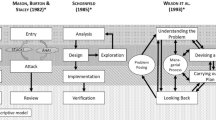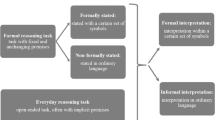Abstract
The objective of this research was to compare two types of models used in problem solving: those which give priority to intermediate qualitative representations, such as the episodic situation model, and those which are centred on the activity of the participant and are of a procedural nature. Two-step distributive problems were chosen that could be solved using two different strategies: factorisation or development. These problems were given to French primary school pupils in year groups 3rd grade (8–9 years old) and 5th grade (10–11 years old). Each problem was formulated in four different ways by crossing two variables which modify the text: on the one hand, the presence of an element structuring the objects enumerated in the problem and on the other hand, the order of the numerical data. We have noted the percentage of ‘factorisation’ strategies used by the pupils. The results show that (1) factorisation was most often used by the older pupils; (2) the presence of a structuring element increased the number of factorisations whereas the order of the numerical data had no effect. This suggests that the problem-solving models which involve the episodic situation model are more suited to result interpretation than procedural models.
Résumé
L’objectif de cette recherche est de confronter deux types de modèles de résolution de problème: d’une part ceux qui attribuent de l’importance à des représentations intermédiaires qualitatives comme le modèle épisodique de situation, d’autre part, ceux qui, centrés sur l’activité du sujet sont de nature procédurale. Dans cette optique, nous avons choisi des problèmes distributifs à deux étapes, que l’on peut résoudre par deux stratégies différentes: la factorisation ou le développement. Les problèmes ont été proposés à des éléves de CE2 (8–9 ans) et de CM2 (10–11 ans) sous quatre formulations différentes résultant du croisement de deux variables qui modifient le texte: d’une part, la présence d’un élément structurant les objets dénombrés dans le problème, d’autre part, l’ordre des données numériques. On relève le pourcentage de stratégies “factorisation” utilisées par les éléves. Les résultats montrent (1) que la factorisation est plus souvent utilisée chez les élèves les plus âgés; (2) que la présence d’un élément structurant augmente le nombre de factorisations, alors que l’ordre des données numériques n’a pas d’effet. Les modèles de résolution accordant un rôle au modèle de situation épisodique, semblent plus adaptés pour interpréter ces résultats que les modèles procéduraux.
Similar content being viewed by others
References
Barrouillet, P. (1991). Evolution des catégories naturelles et résolution des épreuves d’inclusion entre 6 et 10 ans.L’Année Psychologique, 91, 505–531.
Bastien, C. (1997).Les connaissances de l’enfant à l’adulte. Paris: Armand Colin.
Bideaud, J., & Lautrey, J. (1983). De la résolution empirique à la résolution logique du problème d’inclusion: Evolution des résponses en fonction de l’age et des situations expérimentales.Cahiers de Psychologie Cognitive, 3, 295–324.
Bouchafa, H. (1985).La résolution de problème arithmétique: Une approche des stratégies de l’enfant. Thèse de doctorat de psychologie, Université de Provence.
Brousseau, G. (1990). Le contrat didactique: Le milieu.Recherches en Didactique des Mathématiques, 9, 309–336.
Brissiaud, R. (1991).Le livre du maître: “J’apprends les maths”, CP. Paris: Retz-Nathan.
Devidal, M., Fayol, M., & Barrouillet, P. (1997). Stratégies de lecture et résolution de problèmes arithmétiques.L’Année Psychologique, 97, 9–31.
Escarabajal, M.C. (1984). Compréhension et résolution de problèmes additifs.Psychologie Française, 29, 247–252.
Fayol, M., Abdi, H., & Gombert, J.-E. (1987). Arithmetic problems: Formulation and working memory load.Cognition and Instruction, 4, 183–202.
Gerofsky, S. (1996). A linguistic and narrative view of word problems in mathematics education.For the Learning of Mathematics, 16(2), 36–45.
Gravemeijer, K. (1997). Solving word problems: A case of modelling?.Learning and Instruction, 7, 389–397.
Greer, B. (1997). Modelling reality in mathematics classrooms: The case of word problems.Learning and Instruction, 7, 293–308.
Kintsch, W. (1998).Comprehension, a paradigm for cognition. Cambridge: Cambridge University Press.
Kintsch, W., & Greeno, J.G. (1985). Understanding and solving word arithmetic problems.Psychological Review, 92, 109–129.
Nathan, M.J., Kintsch, W., & Young, E. (1992). A theory of algebra-word-problem comprehension and its implications for the design of learning environments.Cognition and Instruction, 9, 329–389.
Passerault, J.M., & Chesnet, D. (1991). Le marquage de paragraphes: Son rôle dans la gestion des traitements pendant la lecture. In G. Denhière (Ed.), Le traitement cognitif du texte.Psychologie Française, no spécial, 36, 159–165.
Ressuer, K. (1989). From text to situation to equation: Cognitive simulation of understanding and solving mathematical word problems. In H. Mandl, N. Bennet, E. De Corte, & H.R. Friedrich (Eds.),Learning and Instruction in an International Context, 2(2), 477–498. Pergamon Press
Reusser, K., & Stebler, R. (1997). Every word problem has a solution — The social rationality of mathematical modelling in schools.Learning and Instruction, 7, 309–328.
Richard, J.F. (1990). Comprendre, raisonner, trouver des solutions. In J.F. Richard (Ed.),Les activités mentales. Paris: Armand Colin.
Riley, M.S., Greeno, J.G., & Heller, J.I. (1983). Development of children’s problem-solving ability in arithmetic. In H. Ginsburg (Ed.),The development of mathematical thinking (pp. 153–196). New York: Academic Press.
Staub, F.C., & Reusser, K. (1995). The role of presentational structures in understanding and solving mathematical word problems. In C.A. Weaver, S. Mannes, & C.R. Fletcher (Eds.),Discourse comprehension Essays in honor of Walter Kintsch (pp. 286–305). Hilsdale, NJ: Lawrence Erlbaum.
Stern, E., & Lehrndorfer, A. (1992). The role of situational context in solving word problems.Cognitive Development, 7, 259–268.
Van Dijk, T.A., & Kintsch, W. (1983).Strategies of Discourse Comprehension. New York: Academic Press.
Verschaffel, L., Greer, B., & De Corte, E. (2000). Making Sense of Word Problems: Contexts of Learning. Heereweg, The Netherlands: Swets & Zeitlinger.
Zagar, D., Fayol, M., & Devidal, M. (1991). Une stratégie de prise d’information particulière à la lecture de problèmes?Psychologie Française, 36, 143–149.
Author information
Authors and Affiliations
Rights and permissions
About this article
Cite this article
Coquin-Viennot, D., Moreau, S. Highlighting the role of the episodic situation model in the solving of arithmetical problems. Eur J Psychol Educ 18, 267–279 (2003). https://doi.org/10.1007/BF03173248
Received:
Revised:
Issue Date:
DOI: https://doi.org/10.1007/BF03173248




